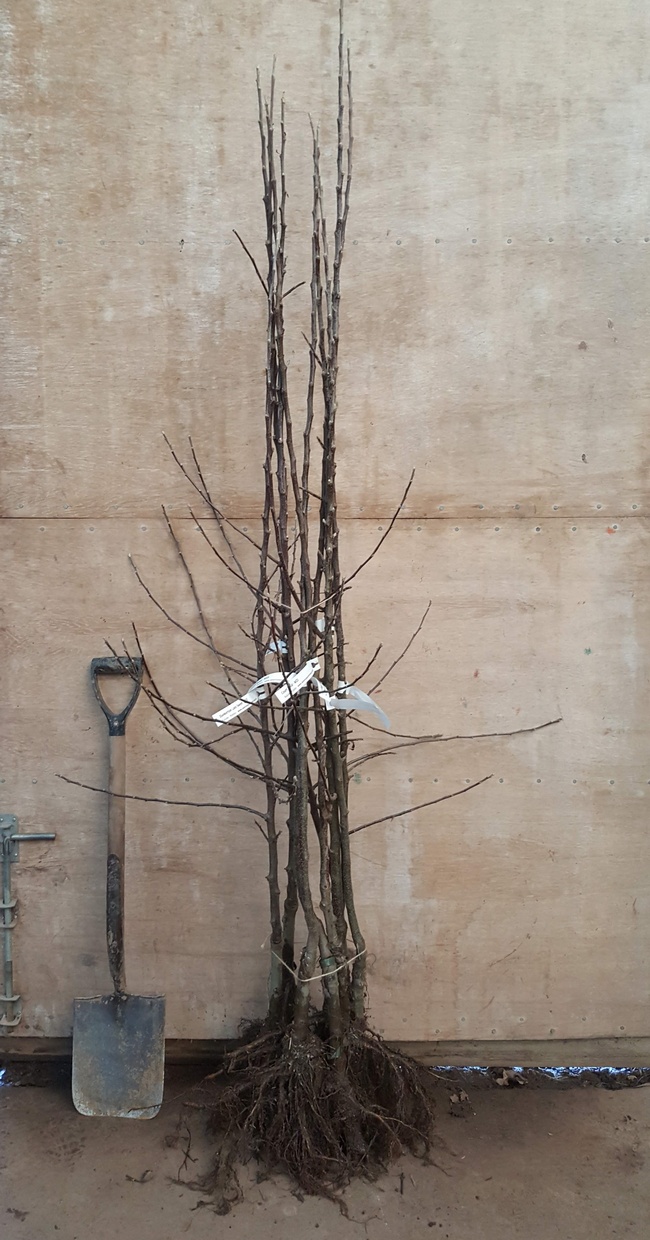 Frequently Asked Questions
Frequently Asked Questions1. What is the recommended spacing for fruit trees ?
This is determined by the rootstock :
The following are considered 'Half-Standard' Rootstocks and require 4-5 metres spacing between trees. This allows for 150-200 trees per acre:
Apples on MM106
Pears/Quince/Medlar on Quince A
Cherries on Colt
Plums on St Julien A
Pears on Pyrodwarf are slightly more vigorous than Quince A and require 5-6m spacing.
Apples on MM111 are slightly more vigorous than MM106 and require 5-6m spacing.
The following are 'Standard' Rootstocks and require 8-10m spacing. This will allow for 40-50 trees per acre:
Apples on M25
Pears on Pyrus Communis
Cherries on F12/1
Plums on Brompton
Always allow more space rather than less. Fruit trees will also grow bigger on clay soils than on sandy soils. Exposed sites and sites at higher altitude will also produce small trees.
2. How big will my trees be on arrival ?
'Maidens'
Our trees are supplied as maidens. The term 'maiden' means they have grown in the nursery for one year. Some varieties will produce side branches in that one year (side branches are refered to as 'feathers'), but others will be a straight stem with no side branches. This is entirely dependent on fruit type and variety. Maidens vary in height, again depending on fruit type and variety, but they will be at least 1.2m tall and generally between 1.5 - 1.8m tall.
'Two Year Olds'
Two year old trees are maidens that have been planted out at the nursery and either cut back to around 1.2m, which encourages production of side branches at 1m, or the maidens are not pruned back and left to 'run on' to produce branching higher up the stem, generally around 1.5m.
As a rule two year old trees will be around 1.8m tall and have well developed side branches that we have trained at around 1-1.5m on the main stem.
3. How tall will the trees grow?
This is determined by the rootstock, soil type, variety and site conditions - but as a general rule:
MM106 , Colt, St. Julien A, Quince A : 4-5m / 12-15ft height and spread.
MM111, Pyrodwarf : 6-8m / 18-24ft height and spread.
M25 , Pyrus Communis, F12/1, Brompton : 8-10m+ / 25-30ft+ height and spread.
4. How should I treat my trees on arrival ?
We package the trees carefully to prevent them drying out and being damaged in transit.
If you are not ready to plant them for a few days keep them somewhere cool and open the packaging a little, to let the stems breath, keep the roots wrapped. They can be stored like this for 7-10 days but make sure the roots are moist to touch not dry.
If the ground is too wet or frozen it is best to delay planting and heel the plants in damp soil/sawdust/compost/sand.
Plant by mid-March .
5. How long will I have to wait to get fruit?
Half standards will crop two years after planting and give good crops by year five.
Full standards will need to form a crown before cropping and this will usually take 3-4 years . Once a crown is formed then cropping will start - you should be getting crops by year 5. Full and heavy cropping will usually be around year 10-12.
6. Should the trees be pruned in the first year?
Maiden trees trees should be pruned shortly after planting before they come into leaf.
Do this by reducing the growth by 30-40cm to a bud. This pruning will encourage cropping branches lower down the tree.
For more advice on pruning see pruning section in growing advice
7. Which varieties are good for training as cordons and espaliers?
The best varieties are good spur bearers but not tip bearers.
Spur bearers are indicated in the features of the apple varieties described. We can put together a special collection of apple varieties suitable for training see apple collections.
All the pear varieties offered train well as cordons or espaliers, Comice and Williams will appreciate a warm sheltered wall, south or west facing.
Plums ,cherries ,peaches and nectarines are best fan trained.
8.Can orders be collected?
You are welcome to collect from the nursery but this does need to be by appointment only - we need to have advance warning to get your order ready.
9. When will my trees arrive?
Our trees are only available bare rooted (no soil around the roots) when they are dormant, between late November - March. We operate a first come, first served system of delivery - if you order your trees in June, for example, they will be delivered early in the delivery season, usually late November.
We will contact you by e-mail to provide you with a delivery week. We try to do this at least two weeks prior to dispatch to give you advance warning. We also email confirmation on the day trees are dispatched from the nursery, with a tracking number from our courier company to track your order in transit.
You can arrange to have your order left in a safe place if you are not expecting to be in when the delivery arrives. They do not require a signature for delivery.
Orders being sent to a mainland U.K address are on a next-day delivery schedule.
Unfortunately due to the large quantities of orders and our own delivery schedule, customers cannot specify exact delivery dates.
10.When is the best time to place an order?
Orders can be placed throughout the year. By September we start to get busy and we tend to sell out of many varieties by Christmas, so if require particular varieties it is best to order early. It is generally best to order through the website.





